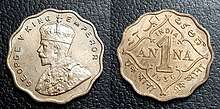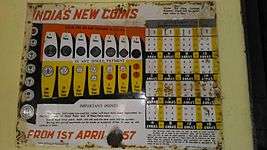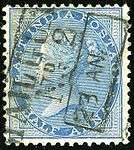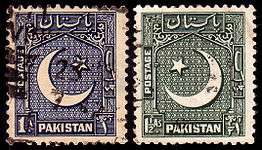Indian anna
An anna (or ānna) was a currency unit formerly used in British India, equal to 1⁄16 of a rupee.[1] It was subdivided into four (old) Paisa or twelve pies (thus there were 192 pies in a rupee). When the rupee was decimalised and subdivided into 100 (new) paise, one anna was therefore equivalent to 6.25 paise. The term belonged to the Islamic monetary system. The anna was demonetised as a currency unit when India decimalised its currency in 1957, followed by Pakistan in 1961. It was replaced by the 5-paise coin, which was itself discontinued in 1994 and demonetised in 2011. Despite this, a 50-paise coin is still sometimes colloquially referred to as 8 annas today, with a 25-paise coin nicknamed 4 annas. The term anna is frequently used to express a fraction of 1⁄16.
| 1 Indian anna | |
|---|---|
 | |
| Obverse: Crowned bust of George VI, with lettering George VI King Emperor. | Reverse: Year of minting and face value in numeral, English, Urdu, Bengali, Telugu and Devanagari scripts. |
| 125,548,000 coins minted (1918 to 1940) in copper-nickel | |
There was a coin of one anna, and also half-anna coins of copper and two-anna pieces of silver.[2] With the rupee having been valued to 1s 6d[3] and weighing 180 grains as a 916.66 fine silver coin,[4] the anna was equivalent to 9/8 d. Hence the 2 anna silver coins were of low weight (22.5 grains = 1.46 g).
Anna-denominated postage stamps were issued during the British Raj by the government of British India as well as by several princely states, and after independence until decimalisation of the currency by India and Pakistan.
Notation
The first number is the number of rupees, the second is the number of annas (1/16), the third is the number of paise (1/64), and the fourth is the number of pies (1/192). Examples are below.
- Rs 1/15/3/2 = Rs 1.9947
- Rs 1/8/3 = Rs 1.546
- Rs 1/4 = Rs 1.25
Anna Coins of British India

The first 1 Anna coin in British India was introduced in 1907, 72 years after the introduction of uniform coinage. The Indian Coinage Act of 1906 provided for a 1 anna coin of copper-nickel. This was an attempt to simplify commercial transactions - prior to this, there were silver coins for 2 anna and above, and there were copper coins of 1/4 anna, with no intermediate denominations. This was also an attempt to reduce the use of precious metals (gold and silver) for coinage purposes. The first 1 anna coins were issued during the reign of Edward VII, followed by coins of similar design for George V & George VI. In 1942, the copper-nickel coin (75% copper, 25% nickel) was changed to nickel-bronze (75% copper, 20% zinc, 5% nickel) due to shortage of nickel caused by the World War II.[5]
Coins
.jpg) 2 Indian anna (1919).
2 Indian anna (1919). Annas - Paisa Conversion Table.
Annas - Paisa Conversion Table.- An 1835 quarter ānā.
Stamps
 Half anna stamp of British India
Half anna stamp of British India- One anna stamp of Alwar
 Two anna stamp of independent India
Two anna stamp of independent India One anna and one and a half anna stamps of independent Pakistan
One anna and one and a half anna stamps of independent Pakistan
See also
- Indian coinage
- British Indian coins
- History of the rupee
References
- "Republic India Coinage".Accessed 14 July 2011.
- "British India Coinage - Coins of Queen Victoria". Reserve Bank of India.
- Schedule of Par Values, Currencies of Metropolitan Areas, The Statesman's Year Book 1947, pg xxiii, Macmillan & Co
- "British India Coinage". Reserve Bank of India.
- https://www.tezbid.com/blogs/blogs/story-of-the-1-anna-coin
| Wikimedia Commons has media related to Anna (coins). |